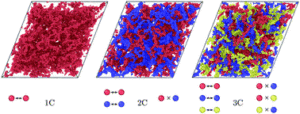Gels are very present in your daily life; the shampoo that you wash your hair with, the gelatine in your mince pies, or your toothpaste. In these examples, the gel is composed of a large amount of liquid which is entrapped in a three-dimensional network of molecules such as surfactants or polymers. Although their liquid content is much larger than their solid content, gels present solid-like mechanical properties such as the presence of an elastic regime at low strain. There is a particular type of gel where this network, instead of being formed by a sequence of molecules, is formed by chains of tiny solid particles (colloids). These are known as colloidal gels.
In this publication, the authors present a thorough numerical study where they model the formation of colloidal gels whose networks are composed of up to three different types of particle chains. Moreover, they correlate the resulting structures with their mechanical properties, enabling the authors to establish predictions on the performance of these gels for different applications. The insights presented in this work are of high relevance not only to advance the understanding of colloidal gels but also to the design of novel soft materials with tailored mechanical properties.
Comments from the authors:
- Understanding the coupling between networks in multi-gels is crucial: different type of mechanical coupling may have very different consequences on the mechanics of the composite material!
- Simulations allowed us to explore scenarios hard to realize in experiments (e.g. the two networks are completely repulsive with each other) but important to disentangle the different ingredients: the gel morphology, the strength of each component and the coupling between the two networks. By doing so, we discovered a mechanism potentially important for tougher gels that we would have not considered otherwise.
- We computed the macroscopic mechanical response, similar to what one would get from rheology measurements in experiments, but analyzing the microscopic motion and structure allowed us to nail down the origin of that macroscopic response.
- We found that increasing the complexity in our gels, by adding multiple same gel components that are repulsive with each other, results in an extended linear regime compared to pure gels. This extended linearity is a consequence of the steric repulsion between different components and highlights the importance of cooperative effects.
- By studying numerically the mechanical response, we showed that our model gels, upon increasing the number of components, become softer and yield at much larger strain than normal gels.
- We also found that the repulsive interaction between different components prevents compactification of the network and allows multi-gels to exhibit collective reorganization to resist bigger deformations than pure gels.
- Our numerical study suggests new strategies of tuning the mechanics of soft composite materials by controlling the inter-gel interactions and may open the road to the design of new materials of great use in soft robotics, batteries and stretchable electronics.
Citation to the paper: Multi-component colloidal gels: interplay between structure and mechanical, C. Ferreiro-Córdova, E. Del Gado, G. Foffi and M. Bouzid. Soft Matter, 2020,16, 4414-4421. DOI: 10.1039/C9SM02410G.
To read the full article click here!
About the web writer
Dr Nacho Martin-Fabiani (@FabianiNacho) is a Vice-Chancellor’s Research Fellow at the Department of Materials, Loughborough University, UK.











